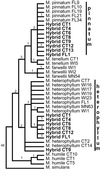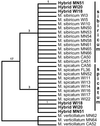Evidence of hybridity in invasive watermilfoil (Myriophyllum) populations
- PMID: 12407174
- PMCID: PMC137510
- DOI: 10.1073/pnas.172391499
Evidence of hybridity in invasive watermilfoil (Myriophyllum) populations
Abstract
Invasions of nonindigenous species have caused ecological devastation to natural communities worldwide, yet the biological bases for invasiveness remain poorly understood. Our studies of invasive watermilfoil (Myriophyllum) populations revealed widespread polymorphisms in biparentally inherited nuclear ribosomal DNA sequences, which were not detected in populations of native North American species. Subclones of the polymorphic regions revealed the occurrence of distinct sequences matching those acquired from both nonindigenous and native North American species. Molecular data demonstrate clearly that invasive watermilfoil populations in North America have resulted from hybridization between nonindigenous and native species. These observations suggest that invasiveness in these aggressive aquatic weeds may be linked to heterosis maintained by vegetative propagation.
Figures



Similar articles
-
Unraveling the biogeographic origins of the Eurasian watermilfoil (Myriophyllum spicatum) invasion in North America.Am J Bot. 2016 Apr;103(4):709-18. doi: 10.3732/ajb.1500476. Epub 2016 Mar 31. Am J Bot. 2016. PMID: 27033316
-
Phylogeny and systematics of Micranthes (Saxifragaceae): an appraisal in European territories.J Plant Res. 2013 Sep;126(5):605-11. doi: 10.1007/s10265-013-0566-2. Epub 2013 May 12. J Plant Res. 2013. PMID: 23665853
-
Phylogenetic placement of the enigmatic and critically endangered genus Saniculiphyllum (Saxifragaceae) inferred from combined analysis of plastid and nuclear DNA sequences.Mol Phylogenet Evol. 2012 Aug;64(2):357-67. doi: 10.1016/j.ympev.2012.04.010. Epub 2012 Apr 24. Mol Phylogenet Evol. 2012. PMID: 22548837
-
Potential of invasive watermilfoil (Myriophyllum spp.) to remediate eutrophic waterbodies with organic and inorganic pollutants.J Environ Manage. 2020 Sep 15;270:110919. doi: 10.1016/j.jenvman.2020.110919. Epub 2020 Jun 16. J Environ Manage. 2020. PMID: 32721351 Review.
-
A Review and Secondary Analysis of Competition-Related Impacts of Nonindigenous Aquatic Plants in the Laurentian Great Lakes.Plants (Basel). 2021 Feb 20;10(2):406. doi: 10.3390/plants10020406. Plants (Basel). 2021. PMID: 33672586 Free PMC article. Review.
Cited by
-
A method to implement continuous characters in digital identification keys that estimates the probability of an annotation.Appl Plant Sci. 2019 May 8;7(5):e01247. doi: 10.1002/aps3.1247. eCollection 2019 May. Appl Plant Sci. 2019. PMID: 31139513 Free PMC article.
-
Influence of geography and environment on patterns of genetic differentiation in a widespread submerged macrophyte, Eurasian watermilfoil (Myriophyllum spicatum L., Haloragaceae).Ecol Evol. 2016 Jan 8;6(2):460-8. doi: 10.1002/ece3.1882. eCollection 2016 Jan. Ecol Evol. 2016. PMID: 26843930 Free PMC article.
-
Hybridization and the colonization of novel habitats by annual sunflowers.Genetica. 2007 Feb;129(2):149-65. doi: 10.1007/s10709-006-9011-y. Epub 2006 Sep 6. Genetica. 2007. PMID: 16955330 Free PMC article.
-
Introgression in peripheral populations and colonization shape the genetic structure of the coastal shrub Armeria pungens.Heredity (Edinb). 2011 Feb;106(2):228-40. doi: 10.1038/hdy.2010.46. Epub 2010 Apr 28. Heredity (Edinb). 2011. PMID: 20424642 Free PMC article.
-
Evidence for gene flow between two sympatric mealybug species (Insecta; Coccoidea; Pseudococcidae).PLoS One. 2014 Feb 11;9(2):e88433. doi: 10.1371/journal.pone.0088433. eCollection 2014. PLoS One. 2014. PMID: 24523894 Free PMC article.
References
-
- Pimentel D., Lach, L., Zuniga, R. & Morrison, D. (2000) Bioscience 50, 53-65.
-
- Scoggan H. J., (1978–79) The Flora of Canada (Canadian Museum of Nature, Ottawa).
-
- Westbrooks R. G., (1998) Invasive Plants, Changing the Landscape of America (Federal Interagency Committee for the Management of Noxious and Exotic Weeds, Washington, DC), pp. 1–9.
-
- Cox G. W., (1999) Alien Species in North America and Hawaii: Impacts on Natural Ecosystems (Island, Washington, DC).
-
- Willis A. J. & Blossey, B. (1999) Biocontr. Sci. Tech. 9, 567-577.
Publication types
MeSH terms
Substances
Associated data
- Actions
- Actions
- Actions
- Actions
- Actions
- Actions
- Actions
- Actions
- Actions
- Actions
- Actions
- Actions
- Actions
- Actions
- Actions
- Actions
- Actions
- Actions
- Actions
- Actions
- Actions
- Actions
- Actions
- Actions
- Actions
- Actions
- Actions
- Actions
- Actions
LinkOut - more resources
Full Text Sources
Other Literature Sources

